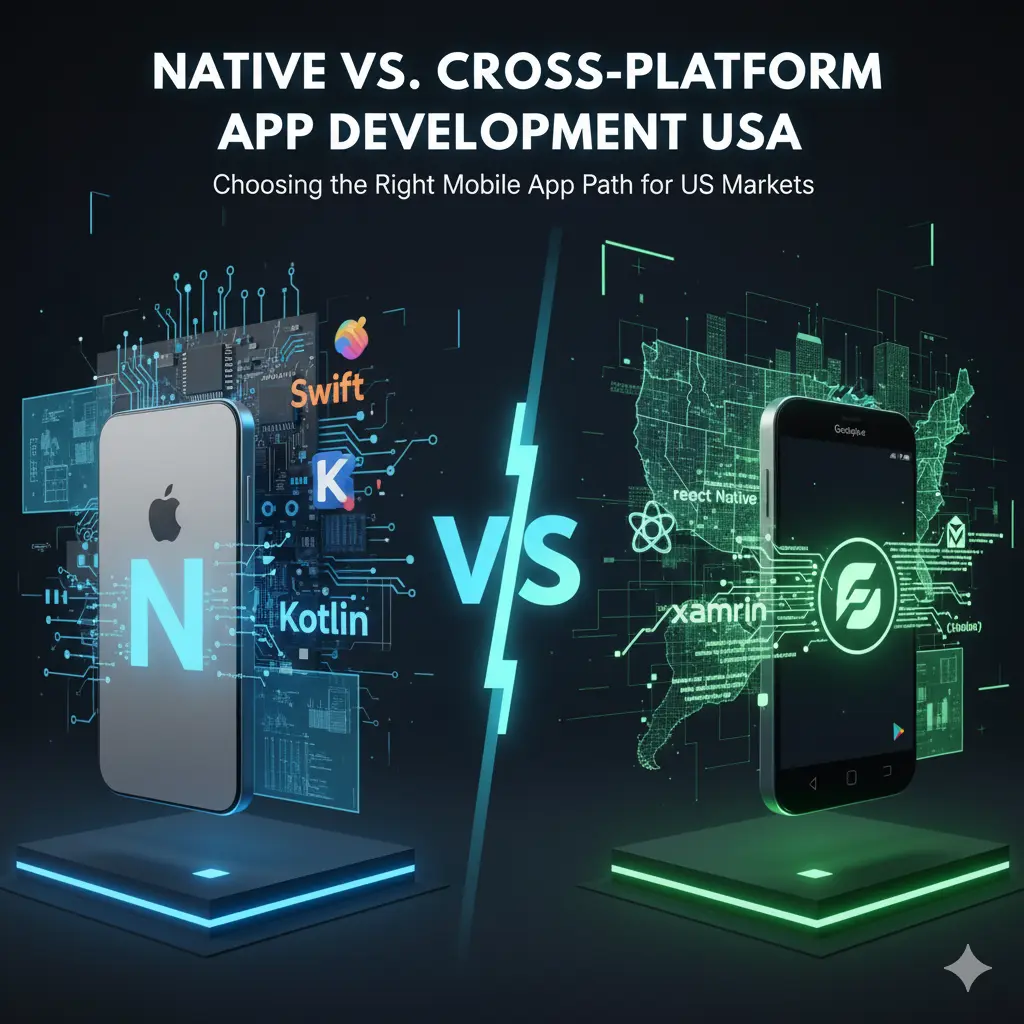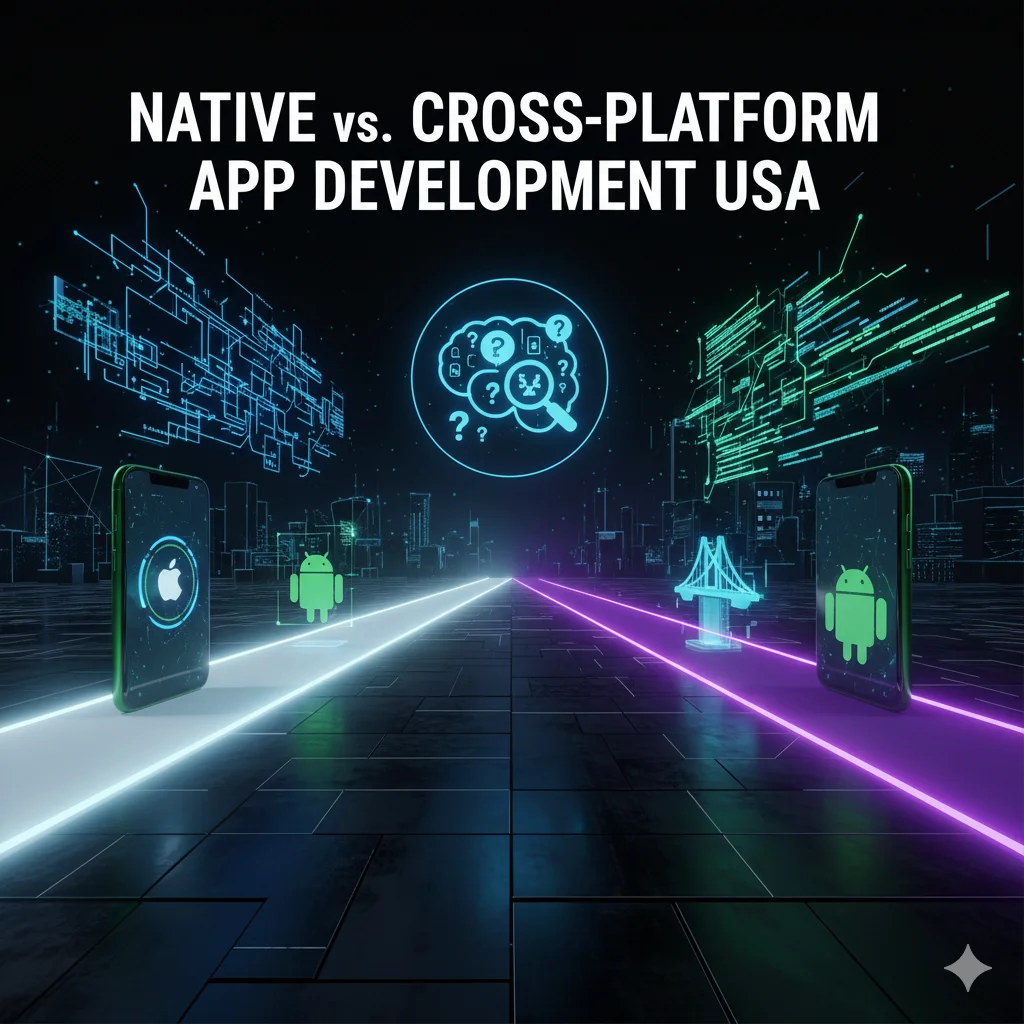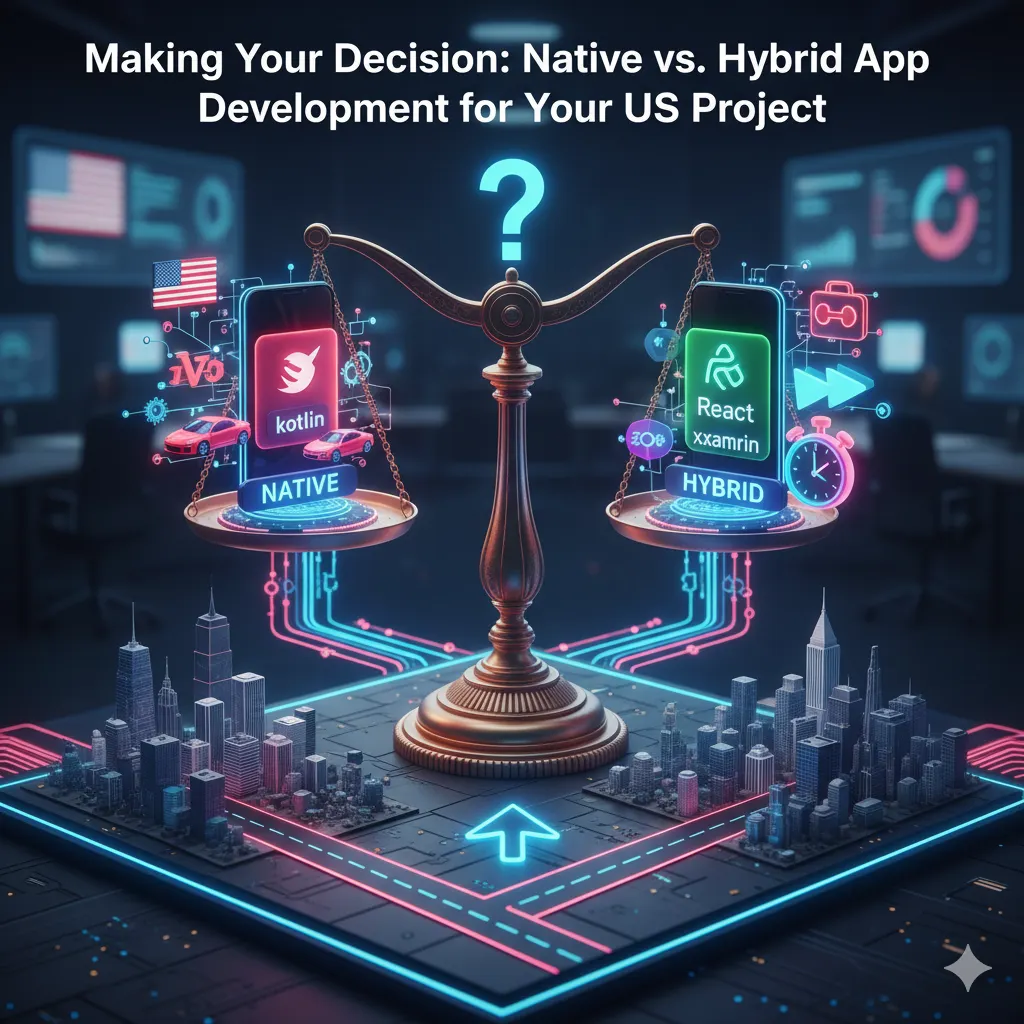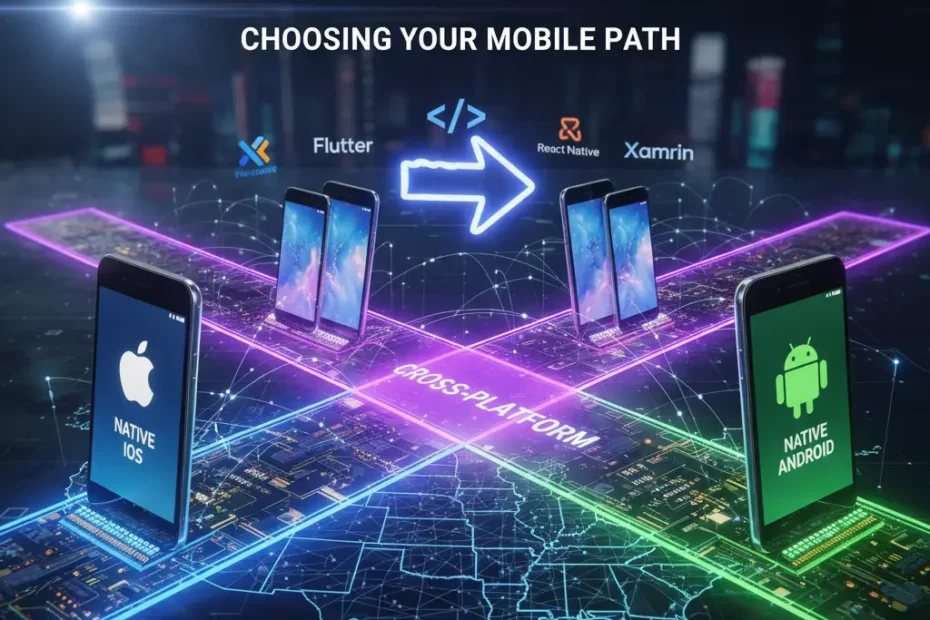Deciding between native vs hybrid app development for the US market? This guide covers the pros & cons, iOS and Android development cost USA, and the best framework for cross platform app 2025 to help you choose the right mobile app path.

In today’s digitally driven landscape, a powerful mobile app is no longer a luxury but a necessity for businesses aiming to connect with American consumers. But before you dive into hiring mobile app development services in the U.S., a fundamental decision awaits: Native vs. Cross-Platform App Development USA. This choice impacts everything from performance and user experience to development timelines and, critically, your iOS and Android development cost USA.
This article will serve as your comprehensive guide, dissecting the merits and drawbacks of each approach, helping you determine “Which is best for my project?” for the highly competitive US market.
Understanding the Core Differences: Native vs. Cross-Platform App Development USA

Let’s clarify what each approach entails before we compare them.
- Native App Development: Involves building separate applications specifically for each platform (iOS and Android) using their respective programming languages (Swift/Objective-C for iOS, Kotlin/Java for Android) and platform-specific SDKs. These apps are optimized for their target device.
- Cross-Platform App Development: Involves writing a single codebase that can be deployed across multiple platforms (iOS and Android) with minor adjustments. Frameworks like React Native, Flutter, and Xamarin are popular for this approach.
Native App Development for the US Market: Pros & Cons
Choosing a native approach for your mobile app in the U.S. means leveraging the full power of each device.
Pros of Native App Development:
| Advantage | Description | Relevance for US Markets |
| Superior Performance | Native apps offer the fastest speeds, most fluid animations, and best responsiveness as they are optimized for a specific OS. | Crucial for high-demand apps (gaming, complex analytics) where US users expect premium experiences. |
| Full Hardware Access | Direct access to device features like camera, GPS, accelerometer, gestures, and notifications without limitations. | Essential for innovative apps utilizing cutting-edge device capabilities, leading to competitive advantage. |
| Best User Experience (UX) | Adheres perfectly to platform-specific UI/UX guidelines (Human Interface Guidelines for iOS, Material Design for Android). | US users are accustomed to platform-specific interactions; native feels more “natural” and intuitive. |
| Enhanced Security | Can leverage platform-specific security features more effectively. | Important for financial, healthcare, or personal data apps where trust is paramount. |
| Fewer Bugs, Better Support | Less reliance on third-party libraries can mean fewer compatibility issues and immediate support for OS updates. | Reduces long-term maintenance costs and improves app stability. |
Cons of Native App Development:
| Disadvantage | Description | Impact on iOS and Android Development Cost USA |
| Higher Development Cost | Requires two separate development teams/codebases (one for iOS, one for Android). | Directly doubles iOS and Android development cost USA and resource allocation. |
| Longer Development Time | Building and maintaining two separate apps takes significantly more time. | Delays market entry, crucial in fast-paced US business environment. |
| More Maintenance | Two codebases mean double the updates, bug fixes, and feature integrations. | Increased ongoing operational expenses for mobile app development services. |
| Platform-Specific Talent | Requires specialized developers for each OS, which can be harder/pricier to source. | Finding skilled native developers in the US can be competitive and costly. |
Cross-Platform App Development for the US Market: Pros & Cons
For many businesses considering mobile app development services, cross-platform offers an appealing balance of reach and efficiency.
Pros of Cross-Platform App Development:
| Advantage | Description | Relevance for US Markets |
| Lower Development Cost | One codebase for both iOS and Android reduces development hours and resources. | Significantly reduces iOS and Android development cost USA, making it accessible for startups and SMBs. |
| Faster Time-to-Market | Simultaneous deployment on both major platforms accelerates launch. | Crucial for capturing market share quickly and responding to trends. |
| Easier Maintenance | Updates and bug fixes can be applied to a single codebase, affecting both versions. | Streamlines ongoing support, reducing operational burden. |
| Wider Audience Reach | Targets both iOS and Android users simultaneously from day one. | Maximizes potential user base across the diverse US mobile landscape. |
| Code Reusability | A significant portion of the code is shared, increasing efficiency. | Maximizes developer productivity and project velocity. |
Cons of Cross-Platform App Development:
| Disadvantage | Description | Impact on User Experience & Cost |
| Potential Performance Issues | May not match native app speed or smoothness, especially for graphics-intensive apps. | Can lead to user frustration if the app feels sluggish, impacting adoption. |
| Limited Hardware Access | Access to certain native device features can be limited or require complex workarounds. | May hinder innovative features that rely on deep hardware integration. |
| Compromised UX/UI | Can sometimes struggle to perfectly match the nuanced UI/UX of each platform. | A generic feel can detract from user satisfaction and brand perception. |
| Dependency on Frameworks | Reliance on third-party frameworks means waiting for updates to support new OS features. | Can create delays if a new OS feature is critical for your app’s functionality. |
| Debugging Complexity | Debugging can sometimes be more complex due to the abstraction layer. | Can increase long-term maintenance time and cost. |
Which is the Best Framework for Cross-Platform App 2025?
While the “best” framework depends on specific project needs, for businesses targeting the US market in 2025, a few stand out as leading contenders among mobile app development services:
- Flutter: Google’s UI toolkit is rapidly gaining traction. Known for its excellent performance (close to native), “hot reload” feature for fast development, and beautiful, customizable UIs. It’s often cited for a superior developer experience and increasingly seen as the best framework for cross platform app 2025 for many projects.
- React Native: Backed by Facebook, it uses JavaScript (a widely known language), making it a popular choice for web developers transitioning to mobile. It has a massive community and a rich ecosystem of libraries.
- Xamarin: Microsoft’s offering, using C#. It’s strong for enterprise applications, especially those integrating with Microsoft backend services.
When considering the best framework for cross platform app 2025, evaluate your team’s existing skill set, the app’s complexity, and the desired user experience.
Which is the Best Framework for Cross-Platform App 2025?

While the “best” framework depends on specific project needs, for businesses targeting the US market in 2025, a few stand out as leading contenders among mobile app development services:
- Flutter: Google’s UI toolkit is rapidly gaining traction. Known for its excellent performance (close to native), “hot reload” feature for fast development, and beautiful, customizable UIs. It’s often cited for a superior developer experience and increasingly seen as the best framework for cross platform app 2025 for many projects.
- React Native: Backed by Facebook, it uses JavaScript (a widely known language), making it a popular choice for web developers transitioning to mobile. It has a massive community and a rich ecosystem of libraries.
- Xamarin: Microsoft’s offering, using C#. It’s strong for enterprise applications, especially those integrating with Microsoft backend services.
When considering the best framework for cross platform app 2025, evaluate your team’s existing skill set, the app’s complexity, and the desired user experience.
Making Your Decision: Native vs. Hybrid App Development for Your US Project

To help you decide, ask yourself these crucial questions:
- What is your budget for iOS and Android development cost USA?
- High Budget & Premium UX is paramount: Lean towards Native.
- Limited Budget & Broad Reach is key: Consider Cross-Platform.
- How quickly do you need to launch in the market?
- Fast launch on both platforms: Cross-Platform.
- Willing to invest more time for ultimate quality: Native.
- Does your app require intense hardware interaction or high performance (e.g., AR/VR, complex games)?
- Yes: Native is likely the superior choice.
- No (standard business app, content-driven): Cross-Platform can be highly effective.
- Is your core user base predominantly on one platform (e.g., iPhone users for a specific niche)?
- Yes: A single native app might suffice initially.
- What are your long-term maintenance and scaling plans?
- Easier, unified maintenance: Cross-Platform.
- Deep, platform-specific optimization: Native.
Ultimately, the choice between native vs hybrid app development is a strategic one, driven by your business goals, target audience, and financial resources. Consulting with experienced mobile app development services in the U.S. can provide tailored advice for your specific project. By carefully weighing the pros and cons, you can confidently choose the mobile app path that will drive success in the dynamic American market.
